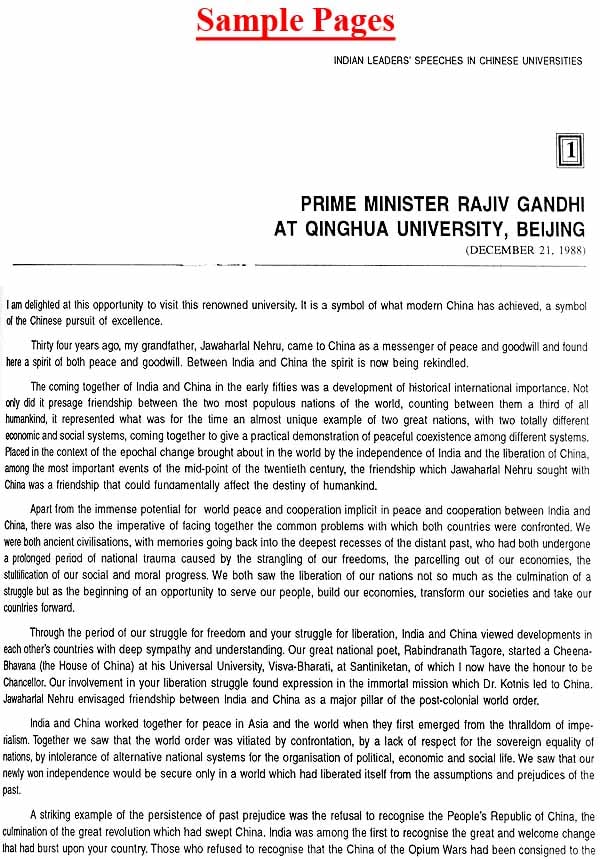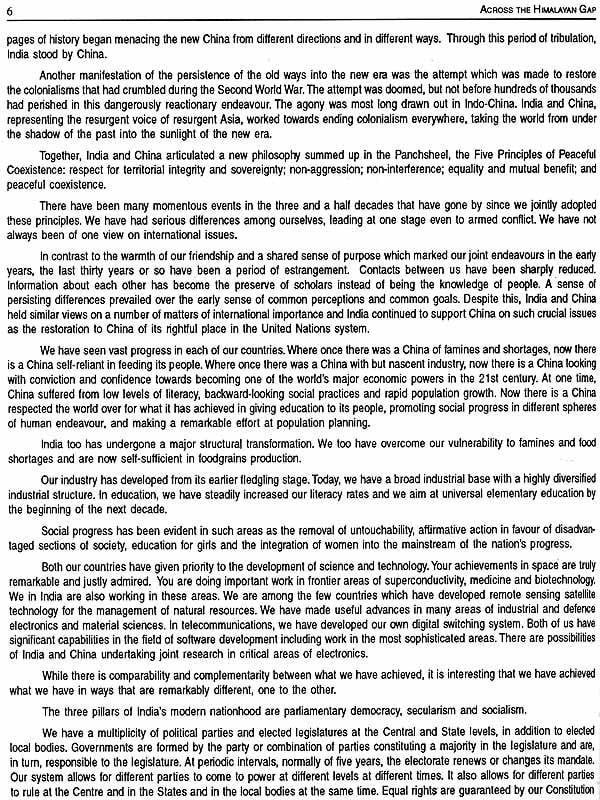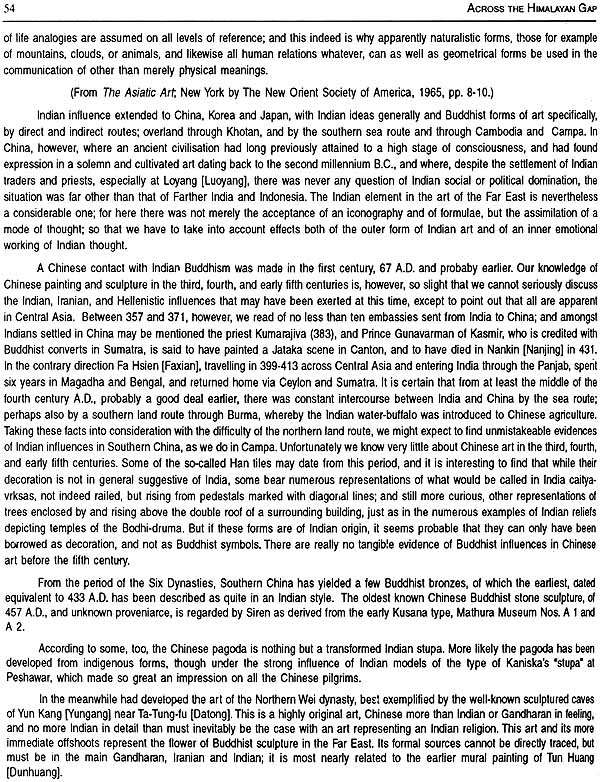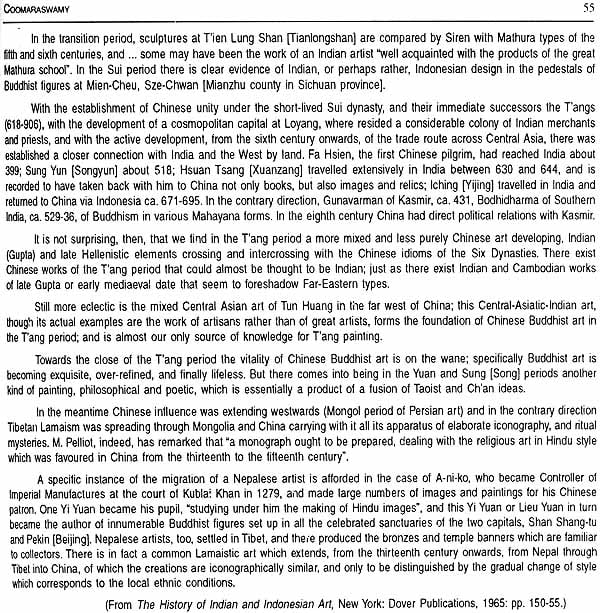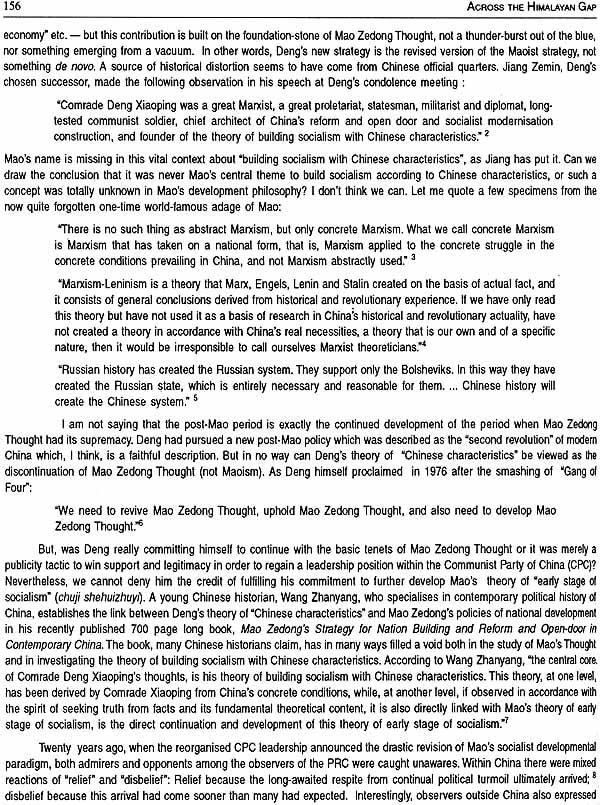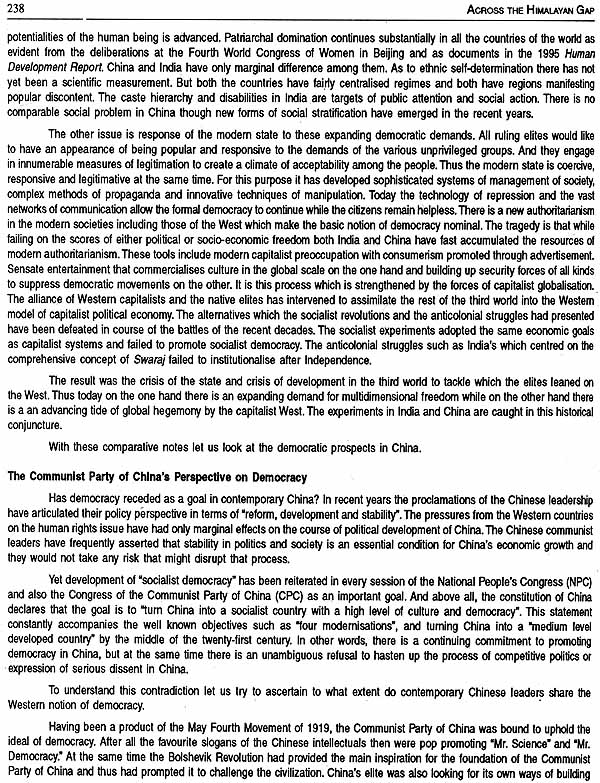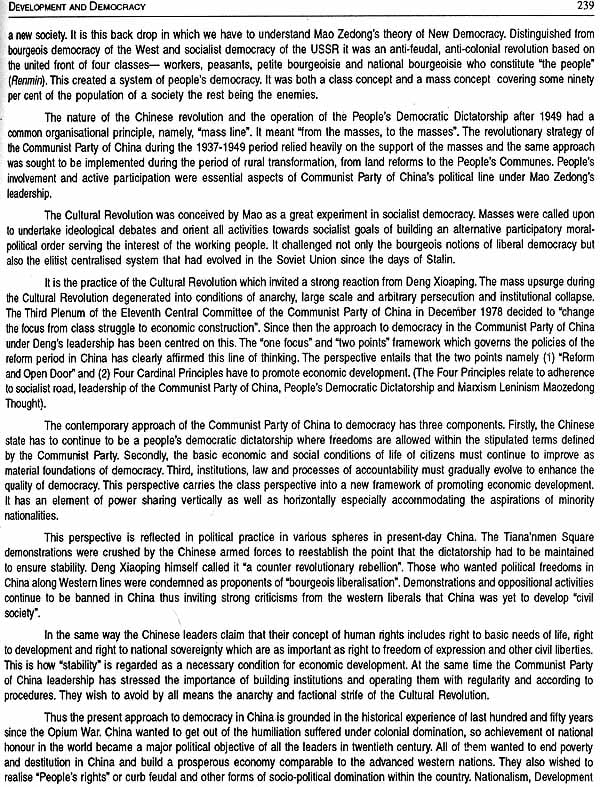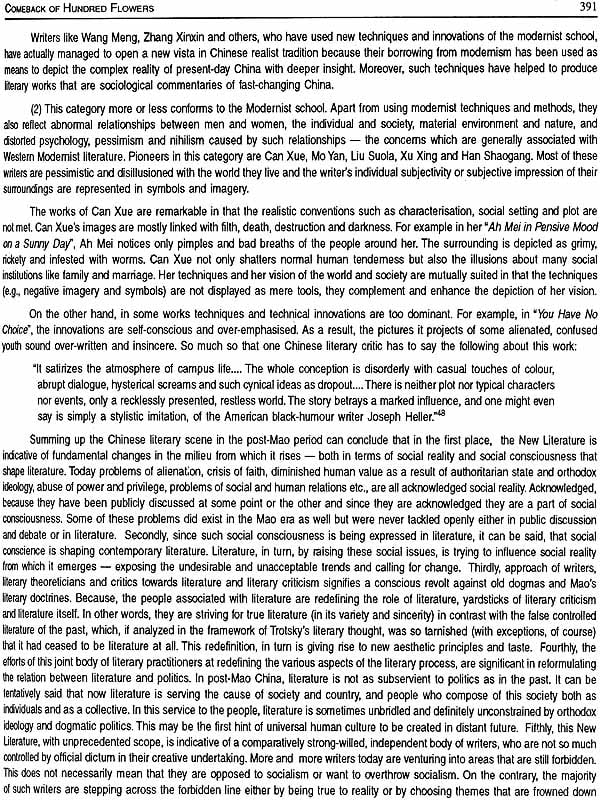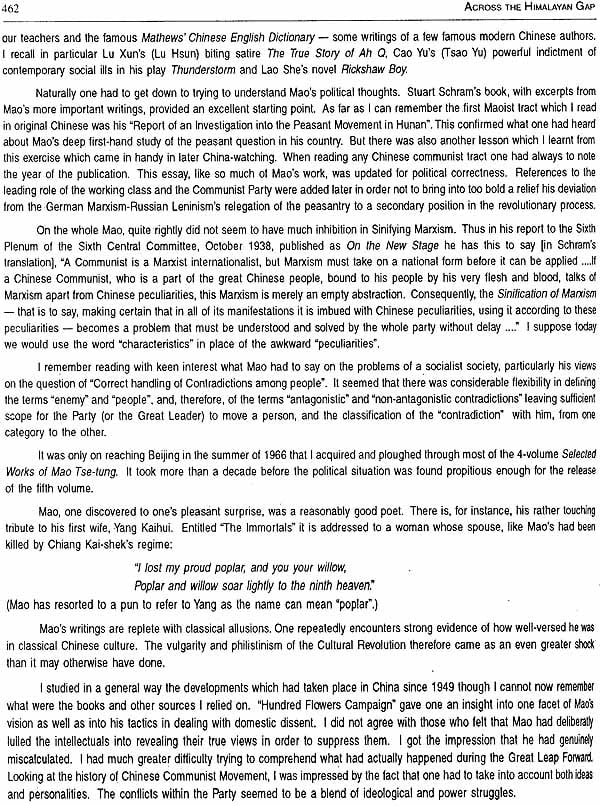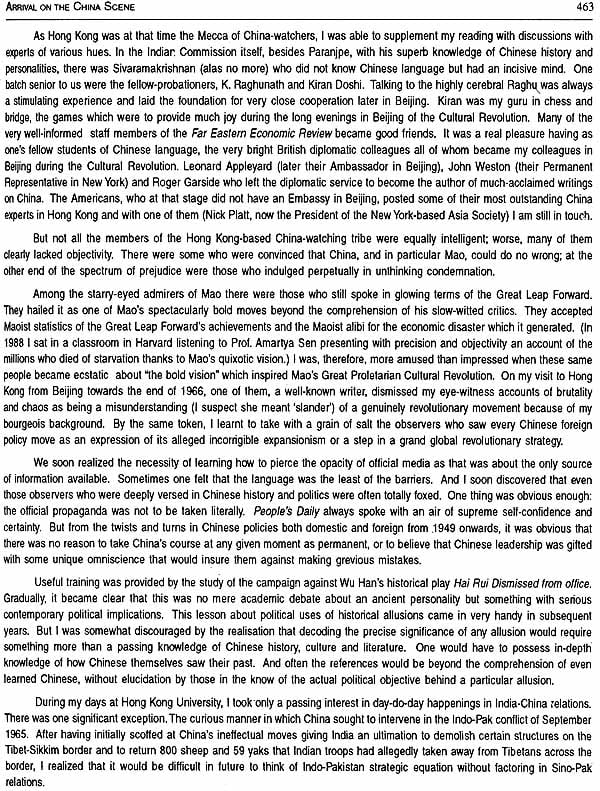
Across the Himalayan Gap (An Indian Quest for Understanding China)
Book Specification
| Item Code: | NAH857 |
| Author: | Tan Chung |
| Publisher: | Indira Gandhi National Centre for the Arts, New Delhi |
| Language: | English |
| Edition: | 1998 |
| ISBN: | 9788121206174 |
| Pages: | 579 (10 B/W and 12 Color Illustrations) |
| Cover: | Hardcover |
| Other Details | 11.0 inch X 8.5 inch |
| Weight | 2 kg |
Book Description
This book is the fruition of Step I of a project launched by the Indira Gandhi National Centre for the Arts (IGNCA) which is a premier Indian research institution dedicated to a holistic understanding of world civilization and to the promotion of information and insight between different cultures of the world. 'Sino-Indian Studies" is a special window of IGNCA drawing inspiration from Gurudeva Rabindranath Tagore's longing for re-enacting the history of the "great pilgrimage" and path-opening"-"to maintain the [Sino-Indian] 'intercourse of culture and friendship", in Tagore's own words. The Academic Director of IGNCA, Dr Kapila Vatsyayan, blazed a new trail in 1990, leading scholars of India and China to "look at each other" instead of trying to see each other's country through the Western Hemisphere. All the 40 Indian authors in this volume have contributed their mite to this endeavour-making it a book that parades the various Indian perspectives on China, on her civilization, history, society and present developments. While scrutinizing their writings, readers also get a glance over Indian savants' observations and Indian leaders' addresses at Chinese universities. The book also targets the Chinese readership with the aim of creating its companion volume of Chinese perspectives on India which is the Step II of the IGNCA project in promoting indepth understanding between the two most populous countries-close neighbours and partners of the 21st century.
Ten Chung IS an Indian citizen of Chinese descent born in Malaya in 1929, having lived first in China for 23 years and then in India for 44 years till date. He stepped into the shoes of his illustrious father. Prof Tan Yun-shan (1898-1983) of Santiniketan - a pioneer of Chinese studies in India and Sino-Indian studies- and contributed to the building up of the Chinese studies programmes in Delhi University and Jawaharlal Nehru University from 1964 up till 1994 when he finally retired from JNU as Professor of Chinese. He has been a Consultant of IGNCA from 1989 onwards to help develop its East Asian Programme. He has authored many books, among which, China and the Brave New World and also Triton and Dragon (a Gyan publication) are textbooks for history courses in Indian and foreign universities. His Dunhuang Art through the Eyes of Duan wenjie is a reference book for-art courses on US and other English language campuses.
Prof. Samuel P. Huntington of Harvard University was here in India last year, and many of us had pleasant interactions with him about the civilizational discourse which we, in India, have been very much concerned all along. The Indira Gandhi National Centre for the Arts (IGNCA), in the 13th year of its youth now, is an institution specially dedicated to culture and art, i.e. the best part of human civilization. As we take a holistic view, we not only treat different civilizations as various manifestations of a whole-the human civilization, but also do not endorse the "Us and Them" proposition as discussed in Huntington's world-famous book The Clash of Civilizations and the Remaking of World Order. "One harmonious world", to the Indian cultural mind, is no euphoria, but a dedication and commitment. To us, nothing is more important than the realization of the "Universal Civilization" in which each component is treating the other as an equal with respect and affection.
The East Asian Programme in our IGNCA was first called the "cell of Sino-Indian Studies" when it was started by Prof. Tan Chung in 1989. Even after this name-change (which means the expansion of its scope), Tan Chung and his colleagues in this unit still work on Si no-Indian Studies as the most endeared field-if not an obsession. For more than two years now the unit has undertaken this project of "India and China Looking at Each Other", and the present volume is the first fruit of this project. My congratulations to Prof. Tan Chung and his colleagues-those who have helped in bringing out this volume. Perhaps, never before has there been any work like this, and in the present volume readers can have a good view of how Indian intelligentsia have looked at China and what have been their concerns. I very much wish that this volume is circulated among the Chinese intellectuals, academicians’ experts and politicians so that they will gain a correct perspective about the "Indian perspectives" on China. Prof. Tan Chung, with cameras at the ready, is eager to capture the Chinese responses so that he and his team will produce a companion volume to this with a sub-title of "Chinese quest for understanding India". I wish him success in these discourses which, I venture to think, would help remove the apprehension in some quarters about the future clashes of civilizations. As Tagore, Nehru and many other Indian savants have said, if India and China can establish an ideal relationship of in-depth understanding of each other, they will play a great role in promoting universal amity and harmony. For, our two countries not only have two-fifths of the world's total population, but these two human communities have carried with them two ancient civilizations and a thick cultural sediment of noble spirit and mental wisdom that would help to overcome the obstacles in the way of creating the Universal Civilization.
The present volume has an impressive list of contributors, some life-long China experts, others with immense information and insight about China. I welcome their contributions and thank their labour of love. Many of them, perhaps, have not had interactions with IGNCA before. Now that we have established our associations, I hope they will return to us again and again, and take interest in what we are doing in IGNCA. I also hope that this volume can attract many more readers who have never read our publications so far. Though' in name ours is an institution of "arts", but it should be understood in the widest sense of the term. Our activities cover creative and critical, written and oral literatures, the oral, written, and visual traditions of a Civilization, lifestyles and the interface between material and spiritual cultures. Our focus, of course, is on India, on all what she has achieved in the long history of her civilizational existence, but we always pursue an open-door policy, and go out and out to appreciate the cultural achievements of other countries and other civilizations on the one hand, and welcome with open arms input from individuals, institutions and other quarters outside India on the other. We have already started some contacts with China, with her culture and art, with her traditions and lifestyles, but we want to enlarge these contacts. Perhaps, this volume will bring us many more friends from India, China and other countries to help strengthen our activities in IGNCA in its multifaceted dimensions. In this volume, strategists and ex-diplomats focus their attentions on Confidence Building Measures and constructive cooperative relationship. To my mind, the best mutual under-standing between different peoples and cultures does not crystal in the mind, but springs from the heart. Only when there is an indepth acquaintance and appreciation of each other’s culture and art can there be the true smile from the heart.
With these words, I offer this volume to our readers and hope the pages are opened with appreciation and critique, resulting in wider participation in our civilization discourse.
India and China between them represent the two oldest continuing civilizations in the world, covering more than one-third of the entire population of Planet Earth. This fact alone highlights the tremendous importance of inter cultural visits and studies between these two nations who have been neighbours ever since history began. Unfortunately, as a result of Western dominance, the ancient links gradually disappeared causing a vacuum which now needs to be filled. The seminar organised by the Indira Gandhi National Centre for the Arts recently was a welcome step in this direction, and the present volume will certainly be an important contribution towards developing a closer understanding between India and China. Hopefully it will be followed in due course by a companion volume entitled "Chinese Perspective on India".
It is well known that Buddhism, which was born in India, became the major cultural link between the two civilizations. China already had a flourishing Confucian tradition with which Buddhism interacted in a positive and non-confrontational manner. Among the many persons who carried the message of the Buddha to China was the famous scholar Kumarajiva who came from my home state of Kashmir. While it is generally known that the Buddhist influence spread from India to China, there is an inadequate appreciation regarding what we have received from China. Tea, porcelain, silk and printing are among the great gifts of China to world civilization.
We are shortly entering the third millennium A.D. For us in India and China, whose civilizations go back much further in time, the event may not be as exciting as it is to the West. Nonetheless, it does mark an important milestone in modern history. If the 19th century has been described as the century of Europe, and the 20th as the century of America, it is possible that the 21st century will be described as the century of Asia, in which China and India will inevitably be major players. A creative interaction between the Indic and the Sinic civilizations will be a major factor in this process.
It is my sincere hope that universities and other academic institutions in India will begin paying closer attention to India-Chinese relations-political, economic and cultural. The Indira Gandhi National Centre for the Arts has made a useful contribution in this direction.
This book partially fulfils the target of our two-year old project entitled "India and China Looking at Each Other". The inspiration behind this project is the now well-known idea propounded by Dr. Kapila Vatsyayan, Academic Director of IGNCA, in the fall of 1990 at the Mogao Caves at Dunhuang, China, that Indians and Chinese stopped trying to know each other’s country's, politics, culture, history, society, etc. through the prism of the Western Hemisphere. Instead, they should look at each other directly. At that time, the learned circles in India had very little access to the Chinese scholarship particularly in the field of her culture and arts. Under the vigorous drive of Dr. Vatsyayan, IGNCA brought the Director of the Dunhuang Academy, Prof. Duan Wenjie, and his senior colleague, Prof. Shi Weixiang, to India, utilized their presence in New Delhi to hold an international seminar on "Cave Art of India and China" in 1991, and mounted an impressive exhibition of the Dunhuang paintings in the premises of IGNCA in 1991-92. Subsequently, we brought out the book Dunhuang Art Through the Eyes of Duan Wenjie in 1994 which has helped Indian scholars to peep into Chinese scholarly efforts in studying the marvellous Dunhuang art treasure.
Quite some water has flowed down the Yangtse and Ganga since Kapila Vatsyayan made the looking-at-each-other call eight years ago. However, academic endeavours are always behind the rapid changes in the world scene. Today, not only the India-China relationship has entered a new phase of constructive cooperation, but the international development portends an urgency that the two ancient and modern civilizations of India and China become more pro-active in uniting Asia, if not the world, in their endeavour of building up a harmonious and just world order while humanity marches into the 21st century. With such a situation in view, we launched the project of "India and China Looking at Each Other" to help accelerating the process of promotion of mutual understanding between India and China. We held a four-day seminar in November, 1995 on "India and China: Looking at Each Other", and a one-day seminar in September, 1996 on "Indian Diplomats' Reminiscences on China". The present volume can be viewed as a harvest-gathering -not only of crops sowed by these two seminars, but much more gleaned from the vast intellectual fields of a total of 40 Indian scholars and experts.
I must hasten to add that much as we would like to bring out a book which should represent the pinnacle achievement of Indian research on China, we know our limitations on two counts. For one thing, to do an extensive research on the past and existing Indian studies on China would take considerable time (at least a couple of years) which will unduly delay the publication of this book, and deprive us-the advantage of timely gathering feedbacks-like the Chinese saying goes: without erecting the pole you won't see its shadow. Another factor is our mixed experience in knocking at the scholarly doors - and many, many times at some of these doors - to beg for treasurable intellectual properties. What is brought out before our readers is the maximum extent to which our persuasion has reached. Apart from such handicaps, we also wish to make the present volume a basic reference book so that it presents, in a nutshell, various dimensions of Indian scholarly interest on China. Thus, our emphasis is on inclusiveness, not selection and elimination. The immediate need in India and abroad, we think, is an overview about the Indian studies on China. The reference value of this volume has been strengthened by the important speeches made by Indian government leaders in China, by excerpts from the writings of the past Indian savants who have said many important things about China, all these which may not be readily available to the interested general public and research scholars. So, this volume has become a kind of parade, a kind of monitor about India's researches, perspectives, opinions, etc. on China. To both the Indian and foreign readership this volume might provide a mirror-of the Indian thinking from various angles about her most important neighbour - China.
But, this volume is more particularly targeting at the Chinese readership. Presently, there is an increasing number of Chinese intellectuals who can read English. When there is something informative or worth telling the Chinese public, there will be interested experts to render them into Chinese and place them under the purview of the wider readership in China. We very much hope the contents of this volume, wholly or partially, be communicated to the Chinese intellectuals, to the Chinese think tank through whom even to the Chinese political leaders. We know that there is a desire on the part of Chinese high-ups to understand India, Indian psyche and Indian attitude towards China, but have not had enough feedback. Doubtlessly, without knowing India well even if China wishes to be India's best friend she will not know how to become. Understanding is the first step towards confidence building measures.
The same will be true for India to befriend China which cannot be achieved by mere goodwill and blind enthusiasm. In fact, it was this blind enthusiasm in the 1950s that has blown up the magnificent bubble of. "Hindi-Cheeni Bhai Bhai" and led the Indian mood onto the arena of illusion and miscalculation. A true India-China rapprochement cannot and should not return to the "Bhai Bhai" days, and let sentiments once again overwhelm rational thinking and cold calculation. Hence, the Indian ruling elite and policy-makers need to know not only how China marches towards her future goals, but also how China and her elite think of India. We notice that although mutual understanding between the two countries has improved substantially, a wide gap between the mental reconstruction and ground reality still exists. In order to bridge this gap we need to supply the Indian perspectives on China to the Chinese, and collect the Chinese perspectives on India and make them available to the Indian intellectual public. This two-way flow of information is what exactly our "Looking At Each Other" project aims at. Thus, after this volume hits the stand we shall try to see it circulated in China. After it is read by Chinese intellectuals there is bound to be reactions and rejoinders etc. Our next agenda is to collect the feedback and bring out its companion volume which will be the "Chinese perspectives on India".
To this volume we have given the title "Across the Himalayan Gap". We hope that when we bring out its companion volume to reflect the Chinese perspectives on India such a title will appear out rightly out-dated. We hope we shall be in a position to declare the disappearance of the "Himalayan Gap" when we christen our next volume. Actually, even in the present volume, we see many Indians, past and present, already flying across the Himalayan gap of Sino-Indian understanding. Resorting to this title actually reflects three things: (1) our strong wish that this gap should be bridged, (2) our bringing out this volume to try to bridge this gap, and (3) a scaffold of the bridge already emerging in this volume. General Banerjee, one of our contributors, has suggested that when we "look at each other", we must not look "merely with our two open eyes, but also with our inner eye", i.e. the eye that "provides a deeper view and a degree of understanding". This summarizes our intention and hope. Of course, we are conscious of the probability that the perspectives reflected by this volume is a one-side view, looking at Chinese developments, historical and current, and also India-China relations only from the Indian vantage position and reflecting only the Indian psyche. It is for the Chinese readers of the volume (and readers all over the world also) to point out the gaps of understanding and what is missing from this volume. I am sure, after we gather the feedback from China (and abroad) many of our authors of this volume would like to re-respond to the Chinese (and other foreign) responses, would like to revise their opinions and conclusions, would like to argue, to debate. Then, intellectually, the relations between India and China would be enlivened, filled with candid exchanges of opinions, trading criticisms, learning how to understand each other with empathy and sympathy. Trading arguments and criticisms to the extent of exhaustion can preclude future trading of blows, and hammering misunderstanding can forge true understanding.
Through the process of doing this volume we have gathered some thoughts. First of all, we don't live in a static and changeless world. As Prime Minister Rao said in China in 1993 that "we are at the threshold of a new century." Of course, our concept of time need not be tied up with the round figures of the" Christian calendar which we call the "Common Era". It is legitimate to argue that the year 2000 or 2001 will be as ordinary as any other year, and there is literally no threshold or gate for us to enter into the 21st century. However, from a general historical viewpoint, we see human evolution already arriving at the crossroad whether we acknowledge it or not. On one plane, the world has completed its journey through the course of Western domination that had begun two or three centuries ago. Even without conceiving any "Asian Century" there is no gainsaying that the Eastern Hemisphere has already wrested a lot of initiatives and dynamism from its erstwhile "better half' - the Western Hemisphere. The universal belief that the West is the upper limit of cultural, in particular, scientific and technological achievements is no longer sustained. The upcoming Eastern countries are contributing greater and greater to the material life of the world that is progressively reducing the human dependence on the Western, especially European industrial output. On another plane, along with the diminution of Western domination there is a change of cultural atmosphere with containment giving way to engagement, rivalry giving way to cooperation, nationalism giving way to globalization, superpower politics giving way to economic interface and synergy. Such a new phenomenon helps us to replace, once for all, the East-West-never-meet scenario by the holistic perspective of East-in-West and West-in-East scenario. Moreover, we are already inside the threshold of the third Revolution - Information Technology. Civilization and culture have become softer and softer despite the spectre of "Clash of Civilizations" courtesy of Harvard Professor Samuel P.0 Huntington. Furthermore, human resources have become more precious than money and machine. Far-sighted seers have begun to attribute non-materialistic elements, like spiritual culture, ethos, dedication, morale, purposiveness, the spirit of sacrifice, and other qualities of the people as vital inputs to progress and economic growth. Considering all this spirit of sacrifice, and other qualities of the people as vital inputs to progress and economic growth. Considering all this epoch-making development at this crucial juncture of century/millennium-turning we must ask the questions: where will India and China stand? Any new challenge and new roles for the two nations to play on the global stage in the coming years?
When we stand at the threshold of a fast moving world we are reminded by what Jawaharlal Nehru said in 1952 that we should "look at the long perspective of history and try to peep into the future, ignoring for the moment our present discontent," and, then, see "the importance of India and China functioning with a measure of cooperation". This volume has provided US with an opportunity to review what Tagore and Nehru have said about the future development of humankind. Our contributors, particularly those who look at India-China relations from a global and futuristic perspective, have echoed in their writings that a new era has dawned in the horizon. Those who have focussed attention on historical developments have also shown a dynamic spirit, and we see their observations vibrating with excitement, reflecting a yearning for new concepts and refreshing perspectives. All this becomes a clarion call to us not only to partake in the excitement and ecstasy of threshold-entering, put to contribute our mite in fuelling a refreshing perspective on India-China relationship.
Secondly, as Ambassador Ranganathan has written in this volume, there is "need for Indians to develop the habit of an independent assessment" while we study China, "rather than depend on borrowed judgements made from different strategic viewpoints." Those of us who teach China or guide research on China in India have long felt the inadequacy of the international scholarship which was dominated by the US campuses. We were yearning for alternative perspectives and also started nursing them. Experience shows that apart from bias and prejudice (which have always been more developed in the developed world and stronger in the strong Western powers than in other countries and areas), it has been disadvantageous to look at Chinese developments from the Western cultural viewpoints than from the Indian.
While doing this volume we are all the more convinced that the time has come for us to develop either an Indian perspective or a Sino-Indian perspective in studying China. By Indian perspective we are translating Kapila Vatsyayan's advocacy into practice, we are taking a direct flight to China, not travelling via the Western Hemisphere. That is to say, we don't carry the extra burden of prejudice emanating from other quarters. This should not be construed as an anti-Western attitude, nor do we intend to exclude the Western Hemisphere from our academic pursuit even if it deals only with India- China interface. The Western Hemisphere has been, and will always be a great source of information and wisdom in all branches of scholarship, not excluding Chinese studies. This proposition, however, does not preclude establishing an Indian perspective on China. The absence of such a perspective, so long, has not only weakened an indepth Indian understanding of China, but also hampered further promotion of mutual understanding between India and China.
In conceiving and delivering this volume we have already experienced the birthpang of creating the Indian perspective on China. We already see Indian scholars, like Prasenjit Duara and his contemporaries in the USA, and Manoranjan Mohanty and a number of others in India, taking a lead in building up the Indian perspective - or a refreshing perspective with a dynamic Indian mind behind it. Prasenjit, in fact, is in an avant-garde position, and he has many decades to shape himself as a new tide in Chinese studies. His writings are an inspiration to those of us who have taught him at Delhi University, and will always be a guiding light and landmark for the younger generations of Indian (also foreign) scholars.
I have used the term "Sino-Indian perspective" which has found echo in this volume from other contributors as well. Readers may discover that when terms such as "Indian perspective" and "Sine-Indian perspective" enjoy limelight, there is always the "Western perspectives" lurking in the dark. Never mind the misnomer of "Western perspectives", its presence here as a kind of whipping boy only shows how eager on our part to blaze a new trail in Chinese studies in India. The whipping boy should not have figured if it had not come in our way. I have no intention to cast any aspersion on Western or US scholarship on China. If there is a situation of someone more equal than others, the others should be equally blamed than someone. Learning from other quarters is not the same thing as surrendering one's own judgement and, worse still, getting into the straitjacket laid by others. Indian scholarship on China can never prosper if it remains a faded carbon copy of the Western scholarship.
Contents
| Acknowledgements | xi | |
| Foreword | xiii | |
| Preface | xv | |
| Introduction | xvii | |
| Indian Leaders' Speeches in Chinese Universities | ||
| 1 | Prime Minister Rajiv Gandhi at Qinghua University, Beijing, 1988 | 5 |
| 2 | Prime Minister Narasimha Rao at Beijing University, 1993 | 13 |
| 3 | Vice-President K.R. Narayanan at Fudan University, Shanghai, 1994 | 19 |
| Indian Savants' Observations on China | ||
| 4 | Raja Rammohun Roy | 27 |
| 5 | Gurudeva Rabindranath Tagore | 29 |
| 6 | Mahatma Gandhi | 35 |
| 7 | Pandit Jawaharlal Nehru | 45 |
| 8 | A.K. Coomaraswami | 53 |
| 9 | P.c. Bagchi | 57 |
| Perspectives | ||
| 10 | A Holistic Eye on Cultural Interface and Synergy | 71 |
| 11 | The Critique of Modernity in India and China | 77 |
| 12 | Enchantment and Disenchantment: A Sino-Indian Introspection | 91 |
| 13 | Gandhi and Mao: National Identity for an Alternative Future | 105 |
| 14 | Body, State and Cosmos: Mao Zedong's "Study of Physical Education" 1917 | 117 |
| 15 | A Sino-Indian Perspective for India-China Understanding | 133 |
| 16 | Unveiling Xuanzang and the Xuanzang Spirit | 149 |
| 17 | Towards an Understanding of Socialism with Chinese Characteristics | 155 |
| Culture and Art | ||
| 18 | Some Aspects of Jataka Paintings in Indian and Chinese (Central Asian) Art | 173 |
| 19 | India and China: Beyond and the Within | 181 |
| 20 | My Tryst with Chinese Art | 193 |
| 21 | Icons of Cultural Linkage | 197 |
| 22 | Cultural Synthesis in the Buddhist Art of China | 203 |
| 23 | New Revelations of Xinjiang Art | 213 |
| 24 | The Creation of Goddess of Mercy from Avalokitesvara | 217 |
| 25 | The Manichaean Input to Chinese Culture and Art | 227 |
| Socio-Political Changes and Economic Development | ||
| Socio-Political Institutions | ||
| 26 | Development and Democracy: The Indian and Chinese Experience | 237 |
| 27 | Understanding "Human Relationships" in China | 243 |
| Economic Developments | ||
| 28 | The Economic Ideas of Mao Zedong: Agricultural Transformation | 253 |
| 29 | Roads for Large Populations Towards Development and Prosperity | 261 |
| Gender Issues | ||
| 30 | Change and Continuity: Orthodox Discourse on Gender Relations in China | 269 |
| 31 | Women and Family in India and China | 287 |
| 32 | Women and Adult Literacy in China | 295 |
| History and Literature | ||
| Tagore and China | ||
| 33 | The Controversial Guest: Tagore's 1924 Visit of China | 311 |
| 34 | Tagore's Inspiration in Chinese New Poetry | 335 |
| Ancients on War | ||
| 35 | Strategic Thinking in Ancient India and China: Kautilya and Sunzi | 357 |
| 36 | Arthashastra and Sunzi Bingfa | 365 |
| Modern Chinese literature | ||
| 37 | The Lofty Height of a Writer: My Evaluation of Lu Xun | 367 |
| 38 | Comeback of Hundred Flowers in Chinese Literature: 1976-1989 | 379 |
| India-China Relationship | ||
| 39 | Mao Zedong's Vision: China, The World and India | 395 |
| 40 | The Nehru Years Revisited | 403 |
| 41 | Retrace Indian Steps in the Agricultural Scene in China 40 Years Back | 415 |
| Diplomats' Reminiscences | ||
| 42 | Interwoven Memories About China | 423 |
| 43 | My Tryst with India-China Friendship-A Talk at IGNCA | 427 |
| 44 | Diary of an Old China Hand | 433 |
| 45 | Delicious Memories-A Talk at IGNCA | 437 |
| 46 | Walk out of the Dinner and Eat It-A Talk at IGNCA | 439 |
| 47 | Memories of An Indian Ambassador, 1987-1991 | 443 |
| 48 | A Young Indian Diplomat in China in the 19605 and 1970s | 449 |
| 49 | How I Arrived on the China Scene | 459 |
| Better Understanding | ||
| 50 | How to Understand China? | 473 |
| 51 | How to Understand Deng Xiaoping's China? | 481 |
| 52 | Positive Agenda for Positive Action: Better India-China | 487 |
| 53 | Indian Policies Towards China-A Talk at IGNCA | 491 |
| 54 | Looking at China Across the Border | 495 |
| 55 | India-China Relations: A Military Perspective | 501 |
| 56 | Three Agreements and Five Principles between India and China | 505 |
| 57 | Building Confidence with China | 519 |
| 58 | China Becoming a Superpower and India's Options | 535 |
| 59 | The Importance of Understanding China | 541 |
| Contributors | 547 |
